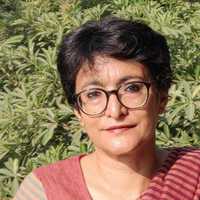- Department of Communication Research, Indian Institute of Mass Communication, Aruna Asaf Ali Marg, New Delhi 110067
- Indian Institute of Mass Communication, Broadcast Journalism, Faculty Memberadd
- Communication, Media Policy, Communication for Development, Broadcast Journalism, Policies, Political economy of Communication, Conflict studies, Public Health Communication, and 5 morePopulation Health, Fertility and Family Planning, Population and Environment, Political Science, Development Studies, and History of Media and Communicationedit
- Experienced Professor of Communication with a demonstrated history of working in the Higher Education industry. Advan... moreExperienced Professor of Communication with a demonstrated history of working in the Higher Education industry. Advance experience in Communication Research, Health Communication, Translation, Journalism, Policy Analysis, and Communication Theory. Strong research professional with a Doctor of Philosophy (PhD) focused on Public Health Communication from Jawaharlal Nehru University, New Delhiedit
The article critically historicises the growth and development of state-owned All India Radio (AIR) as a medium of political communication while dealing with its political economy operating in the realms of developmentalist nationalism.... more
The article critically historicises the growth and development of state-owned All India Radio (AIR) as a medium of political communication while dealing with its political economy operating in the realms of developmentalist nationalism.
The article argues that AIR played a significant role in the entire popular, mainstream construction of the modern Indian nation-state as a single entity created out of varied nations and nationalities. The article deals with the criticalities attached with the construction of post-colonial nationalism and the role played by AIR in projecting and propagating state’s nationalism through the popularisation of certain kinds of political imagination through the process of standardisation of language and music.
As for methodology, the article, while dealing with various case studies relating to All India Radio, theoretically discusses and problematises the construction of the modern nation-states, nationalism, social and cultural integration and the role played by AIR.
The article argues that AIR played a significant role in the entire popular, mainstream construction of the modern Indian nation-state as a single entity created out of varied nations and nationalities. The article deals with the criticalities attached with the construction of post-colonial nationalism and the role played by AIR in projecting and propagating state’s nationalism through the popularisation of certain kinds of political imagination through the process of standardisation of language and music.
As for methodology, the article, while dealing with various case studies relating to All India Radio, theoretically discusses and problematises the construction of the modern nation-states, nationalism, social and cultural integration and the role played by AIR.
Research Interests:
Research Interests:
Research Interests:
Growth of media in the northeast of India has been a slow story. Even state owned radio grew fast only after 1962 Chinese aggression. Similarly, television made in roads during the 1982 Asian Games under government control. India saw a... more
Growth of media in the northeast of India has been a slow story. Even state owned radio grew fast only after 1962 Chinese aggression. Similarly, television made in roads during the 1982 Asian Games under government control. India saw a spurt in the growth of private satellite television channels in the late 1990s. In Assam 2003 saw the launch of the first ‘indigenous’ satellite channel and since then more than a dozen channels have come up, all located in Guwahati and allegedly programming for the entire northeast. This paper critically examines whether the content of these channels are ‘indigenous’? Does it have any relation to the ownership pattern? Has it helped in projecting northeast in a more representative way to the mainstream Indian milieu?
Key words: Television, northeast India, regional television, Indian Media.
Key words: Television, northeast India, regional television, Indian Media.
Research Interests:
Family Planning program which started in India in the 1950s had seen a strong research in communication of the program as well. This paper looks at the role the Ford Foundation had played in giving it a direction.
